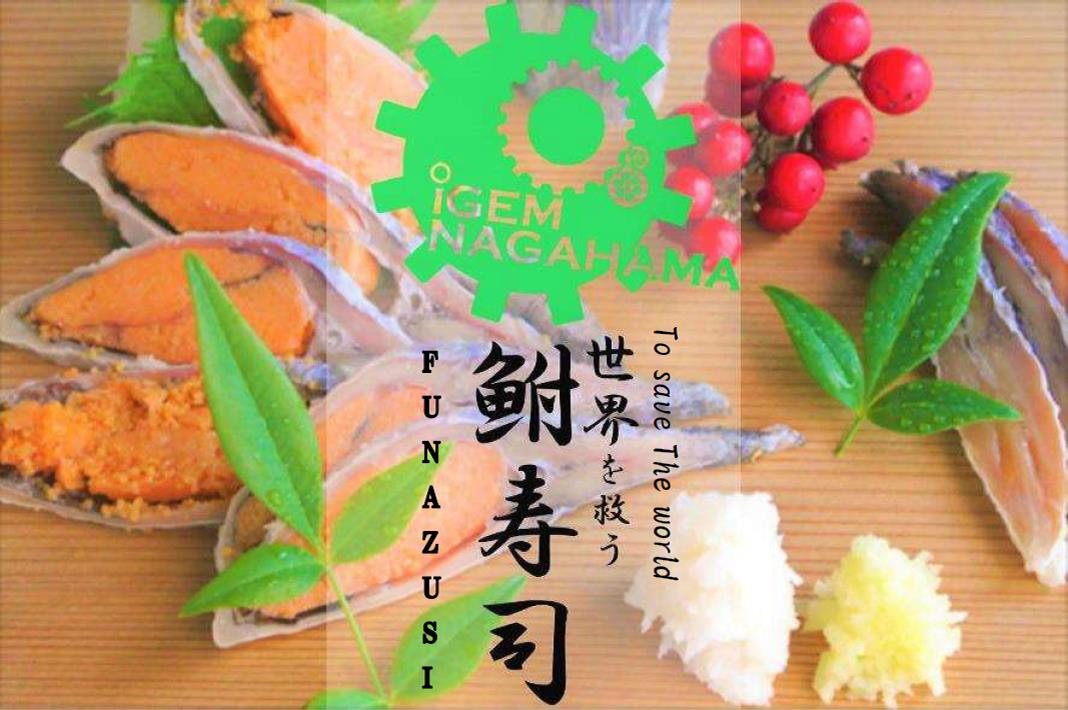Nagahama
Contents
Design of nutritious food based on “Funazushi”
ABSTRACT
Our team wants to make nutritious foods that can be stored for a long time to help people suffering from hunger.
Food problems are a serious matter in the world. Among them, starvation is the one. Our team made nutritious foods that can be stored for a long time to help people suffering from hunger.Starvation is caused by the fact that not only calories but also nutrients such as protein are short. Therefore, we proposed nutritious food that can be stored for a long time by fermentation mainly using fish which is a protein source which does not cost money to raise.We focused on the fermented food called Funazushi which rooted in the area where we live in. We thought that we develop nutritious food by recombining Saccharomyces cerevisiae which was dominant species of Funazushi and making S. cerevisiae produces nutrients lacking in the area.We chose Vitamin A as nutrient added this time.Vitamin A deficiency is one of 3 major micronutrient deficiencies.
Vitamin A, a fat-soluble vitamin, accumulates in the body when it ingests excessively, causing side effects.So we decided to make S. cerevisiae synthesizing β-carotene which is a precursor of vitamin A converting to vitamin A in the body as necessary.In addition, Funazushi is fermented at high salt concentration and low pH. In order to add more nutritional value to Funazushi, we needed to develop new recombinant S. cerevisiae that not only makes more nutrition but also adapts severe environment.Our S. cerevisiae was designed to grow and stand at high salt concentration and low pH.
Here, we show our strategy following three sequential steps towards accomplishing our goal.
(1)Overexpression of endogenous HAA1 gene of S.cerevisiae adapted to low pH.Overexpression of endogenous HAA1 gene of S.cerevisiae adapted to low pH. HAA1 is transcriptional activator involved in adaptation to weak acid stress and activates ranscription of TPO2, YRO2, and other genes encoding membrane stress proteins.
(2)Insertion of sod2 gene (Na + / H + antiporter) derived from Schizosaccharomyces pombe into the plasmid and it's introduction, enable to grow at high salt concentration.
(3)Carotenoid biosynthesis genes (crtE, crtYB and crtI derived from X.dendrorhous) are inserted on the genome of S. cerevisiae.
(4)In order to increase production of beta-carotene, HMG1 gene which catalyzes conversion of HMG-CoA to mevalonate as rate-limiting step in sterol biosynthesis is also inserted on the genome of S. cerevisiae by homologous recombination.
By using of this microorganism we can make more valuable nutrient Funazushi with high amount of beta-carotene than ever through fermentation.
The results we obtained are as follows:
(1)We could not complete DNA fragment overexpressesing HAA1.
(2)S. cerevisiae engineered with sod2 parts [http://parts.igem.org/Part:BBa_K2256000#Confirmation_that_S._cerevisiae_expressing_sod2_acquired_salt_tolerance (BBa_K2256000)] standing salt tolerance was confirmaed.We were able to validate our constructed genes working well.
(3)β-caroten was produced probably by S. cerevisiae engineered with β-carotene synthesize device. We insertion of crtYB, crtI and crtE resulted in orange colonies.
(4)β-caroten production probably was increase by S. cerevisiae engineered with device for increasing β-carotene production.Transformation of tHMG1 to S. cerevisiae synthesizing carotenoid resulted in yellow colonies.
We were able to characterize that color of colony was changed yellow from orange when tHMG1 [http://parts.igem.org/Part:BBa_K849000 (BBa_K849000)]was inserted into S. cerevisiae synthesizing carotenoid.
TRACK
Food Nutrition
We certainly achieved GOLD Medal Criteria!
Bronze Medal
| 1 | Register for iGEM, have a great summer, and attend the Giant Jamboree. | Yes, we are looking forward to taking part in the Giant Jamboree. |
| 2 | Meet all deliverables on the Competition Deliverables page (section 4). | We meet all requirements. |
| 3 | Create a page on your team wiki with clear attribution of each aspect of your project. This page must clearly designate work done by the students and distinguish it from work done by others, including host labs, advisors, instructors, sponsors, professional website designers, artists, and commercial services. | Please check here. |
| 4 | Participate in the Interlab Measurement Study and/or improve the characterization of an existing BioBrick Part or Device and enter this information on that part's Main Page in the Registry. The part that you are characterizing must NOT be from a 2017 part number range. | Please check here. |
Silver Medal
| 1 | Convince the judges that at least one new BioBrick Part of your own design that is central to your project works as expected. Document the experimental characterization of this part on the Main Page of that Part’s Registry entry. Submit a sample of this new part to the iGEM Parts Registry (following Registry submission guidelines). This working part must be different from the part documented in gold #2. | We created a new BioBrick for silver medal criterion. Please look at [http://parts.igem.org/Part:BBa_K2256000 BBa_K2256000]. |
| 2 | Convince the judges you have significantly worked with any other registered iGEM team in a meaningful way. For example, mentor a team, characterize a part, troubleshoot a project, model/simulate a system or validate a software/hardware solution to a synbio problem, or be the recipient of any of these activities. | Please check here. |
| 3 | Convince the judges you have thought carefully and creatively about whether your work is safe, responsible and good for the world. You could accomplish this through engaging with your local, national and/or international communities or other approaches. Please note that standard surveys will not fulfill this criteria.. | Please check here. |
Gold Medal
| 1 | Expand on your silver medal activity by demonstrating how you have integrated the investigated issues into the design and/or execution of your project. | Please check here. |
| 2 | Improve the function of an existing BioBrick Part. The original part must NOT be from your 2017 part number range. If you change the original part sequence, you must submit a new part. In addition, both the new and original part pages must reference each other. | We haven't done it. |
| 3 | Convince the judges that your project's design and/or implementation is based on insight you have gained from modeling. Thoroughly document your model's contribution to your project on your team's wiki, including assumptions, relevant data, and model results. | We haven't done it. |
| 4 | Convince the judges that your project works. | Please check here. |



